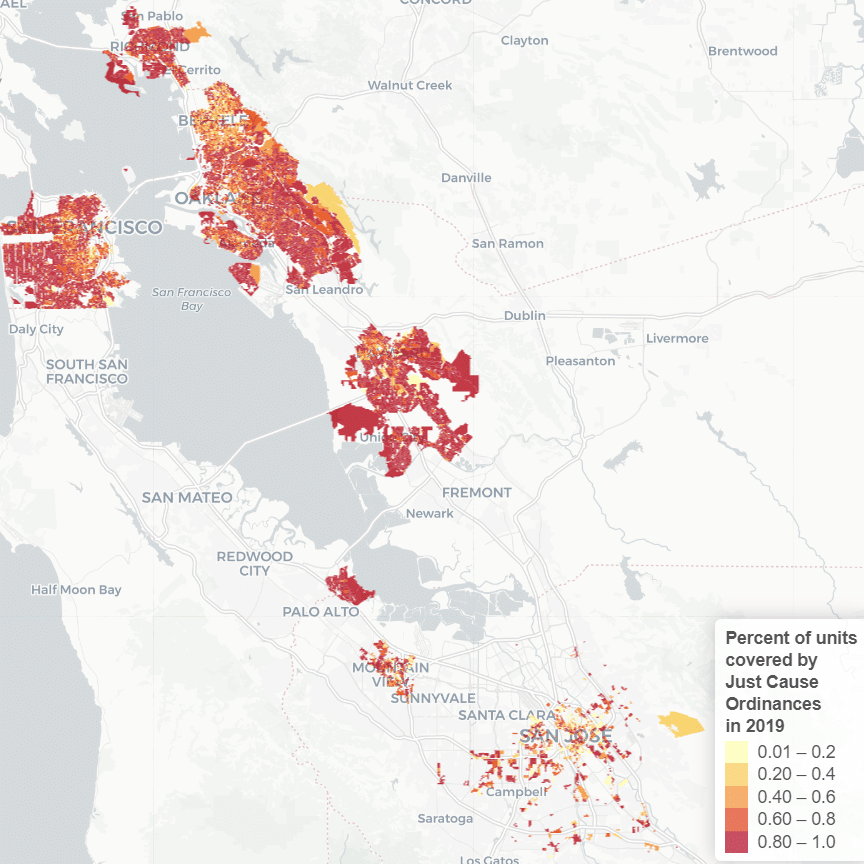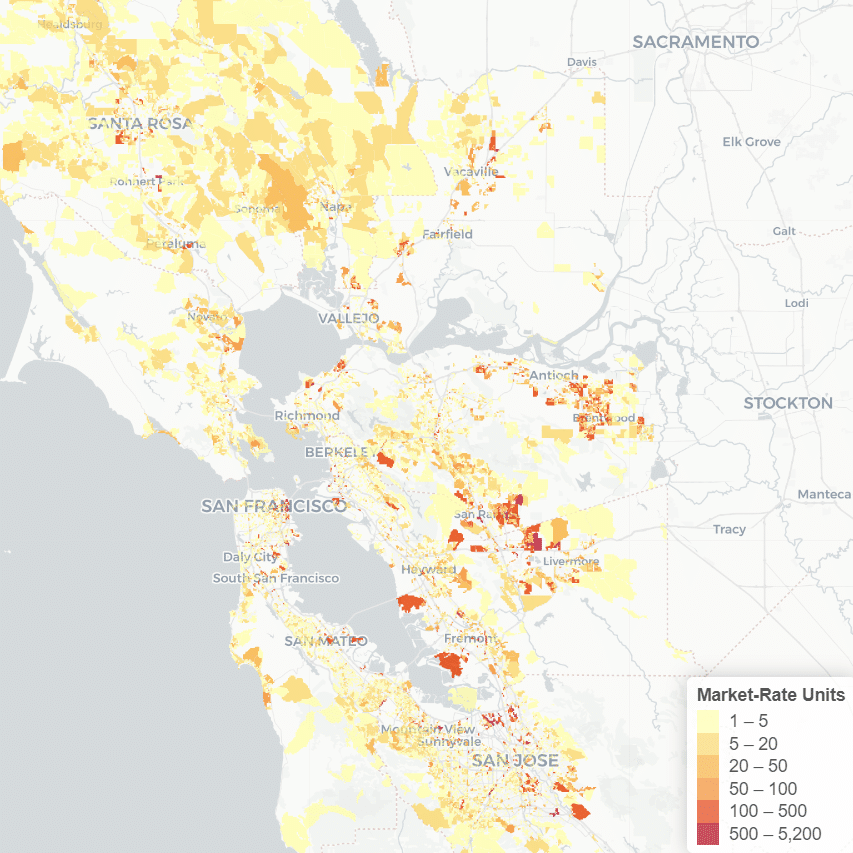SB 50 is the fruit of nearly a year and a half of negotiations around Senator Scott Wiener’s legislative proposal to upzone, or increase allowable density, near transit. Responding to critiques of the first iteration of this legislative proposal, SB 827 (which we also examined in a policy brief), SB 50 makes several modifications. Changes between SB 827 and SB 50 include:
- Expanding to new “job-rich” (even if not transit-adjacent) geographies to unlock exclusive neighborhoods and advance fair housing goals.
- Tightening redevelopment restrictions on rental properties to better protect sitting tenants.
- Giving “sensitive communities” more time to plan and implement anti-displacement strategies.
- Imposing SB 50-specific inclusionary requirements where these would call for a greater number of affordable units than local ordinances.
But what do all these changes really mean for Bay Area communities?
In this policy brief, we analyze the potential impact of SB 50 on financially-feasible housing production capacity in the Bay Area for both market-rate and inclusionary affordable units, focusing on the impacts of modifications made to the bill since SB 827. Specifically, we examine how changes to the inclusionary housing provision, and the addition of the sensitive communities and high-opportunity/commute-reducing geographies, impact the distribution of additional housing capacity across different types of neighborhoods. Notably, the policy lacks a clear definition of “job-rich” areas, so we consider the high-opportunity and commute-reducing geography created by UC-Berkeley’s Haas Institute for a Fair and Inclusive Society, Terner Center for Housing Innovation, and the Urban Displacement Project, as well as California Housing Partnership.
In examining SB 50’s impacts on new housing capacity, we find potential benefits:
- SB 50 could quadruple overall market-feasible capacity in the affected geography.
- SB 50 could quintuple capacity for on-site inclusionary affordable units, including in higher resource areas. However, given that the bill language provides the option to pay in-lieu fees instead of build affordable units on-site, further clarification is needed to ensure that off-site inclusionary units get built nearby.
- The incorporation of a high-opportunity and commute-reducing geography in SB 50, which expands the policy geography beyond SB 827’s transit-oriented upzoning, could help target market-feasible capacity to higher resource areas, and could shift the share of added capacity under SB 50 away from low-resource neighborhoods and toward higher resource neighborhoods.
We also find that the bill still has room for improvement:
- While the provision for delayed implementation in “sensitive communities” would primarily apply to
communities that are at risk of or undergoing gentrification, this geography could be better targeted since many gentrifying and at-risk neighborhoods are not covered by the current definition of sensitive communities. It is important to clarify the goal of this provision and ensure that neighborhoods with displacement pressures have time to plan for and implement anti-displacement strategies.
- Our analysis considered a definition of a high-opportunity and commute-reducing geography that effectively targets higher resource areas, shifting the proportions of overall added capacity under SB 50 away from lower resource areas. In order to ensure the bill delivers on its fair housing goals, a definition like this one should be adopted in bill language.
Under the current bill language, developers may opt for in-lieu fees even where on-site affordable units are financially-feasible, potentially resulting in reduced inclusionary development in higher resource neighborhoods. If fair housing and increasing the number of affordable units in high-resource neighborhoods is a policy goal of the bill, further clarification is needed to ensure that off-site inclusionary units get built nearby. - Overall, policy details matter, and a key point of improvement for the bill will be to more clearly outline how redevelopment restrictions will be enforced given the lack of a rent registry. Without clarity on implementation of this provision, it will be difficult to actually prevent upzoning-related demolition of rental properties.
- Additionally, while the current bill would theoretically protect renters from direct displacement from demolition, indirect displacement pressures resulting from potential increases in land and housing prices could still pose significant risk to existing and future low-income residents. These risks should be addressed by passing stronger statewide tenant protections, and exploring other strategies to prevent indirect displacement.
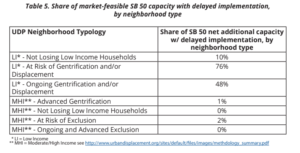
Read about the detailed analyses and findings in the policy brief: Upzoning California: What are the implications of SB 50 for Bay Area neighborhoods?

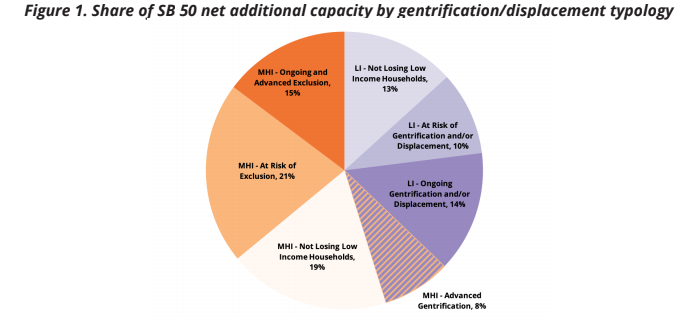
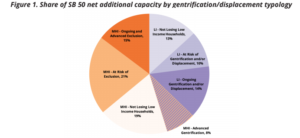
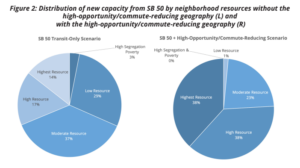 communities that are at risk of or undergoing gentrification, this geography could be better targeted since many gentrifying and at-risk neighborhoods are not covered by the current definition of sensitive communities. It is important to clarify the goal of this provision and ensure that neighborhoods with displacement pressures have time to plan for and implement anti-displacement strategies.
communities that are at risk of or undergoing gentrification, this geography could be better targeted since many gentrifying and at-risk neighborhoods are not covered by the current definition of sensitive communities. It is important to clarify the goal of this provision and ensure that neighborhoods with displacement pressures have time to plan for and implement anti-displacement strategies.